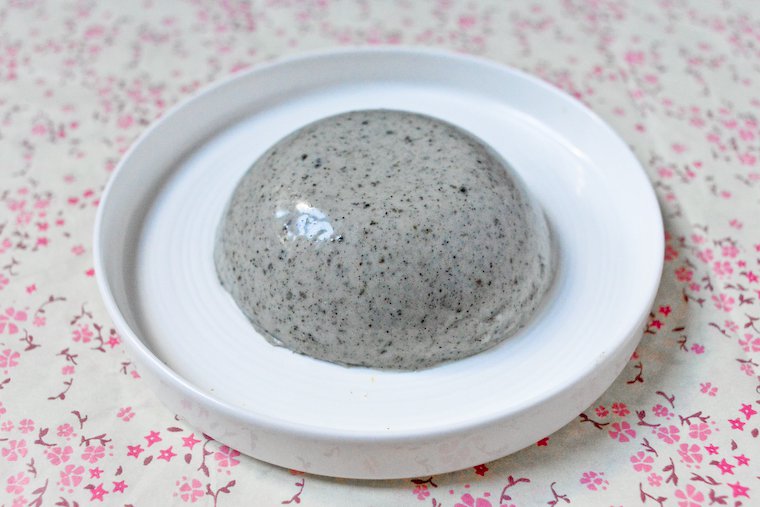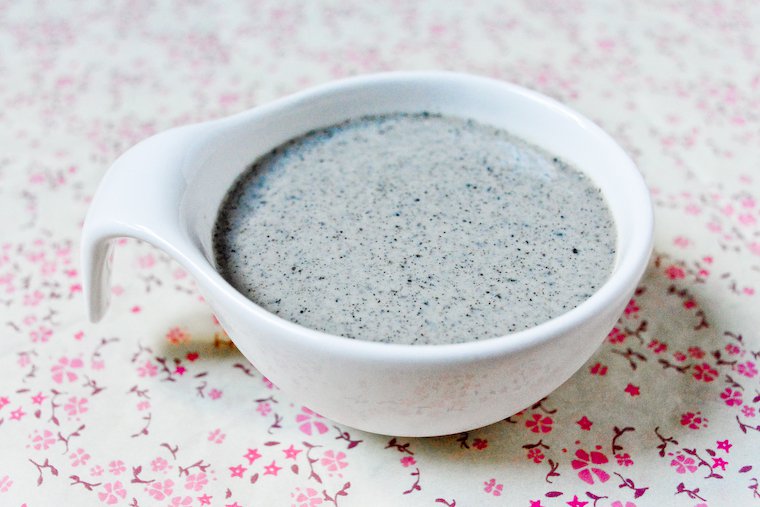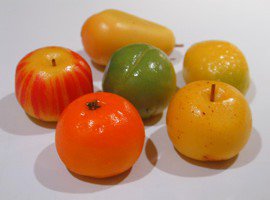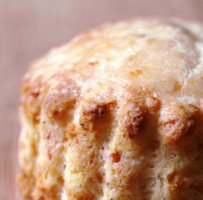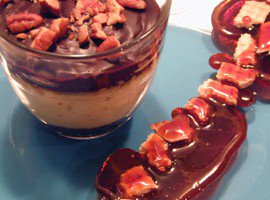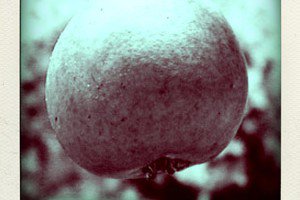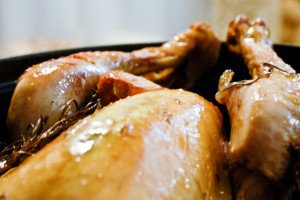I have been enjoying Kaori Endo‘s food for years, from when she was cooking at Rose Bakery, to her charming book Une Japonaise à Paris (accessible, family-style Japanese cooking) and then to the opening of her wildly successful restaurant Nanashi*.
There she serves a short selection of dishes of Japanese inspiration, with three different bento-style meals — one with meat, one with fish, one vegetarian — that each feature a mix of whole grains, and three seasonal(ish) vegetable preparations combining the raw and the cooked.
It is all fresh and tasty and healthful — you can view pictures on their Facebook page — and it usually leaves a little bit of room for dessert, and that is a good thing because you don’t want to pass up Kaori Endo’s delicate creations.
 So when I received her freshly released book Les Bento de Nanashi, I was of course interested to read about her kakuni pork, her ponzu dressing, and her fried tofu with nori sauce, but I was also very happy to reach the dessert chapter and see that she had included a recipe for the restaurant’s black sesame panna cotta, which she credits to pastry cook Megumi Takehana.
So when I received her freshly released book Les Bento de Nanashi, I was of course interested to read about her kakuni pork, her ponzu dressing, and her fried tofu with nori sauce, but I was also very happy to reach the dessert chapter and see that she had included a recipe for the restaurant’s black sesame panna cotta, which she credits to pastry cook Megumi Takehana.
You see, I had an open jar of black sesame paste in my fridge for which I’d been trying to find cool uses — including a delicious ice cream and a psyllium mochi I’ll write about sometime — and I knew this would be just the thing to showcase the uniquely irresistible, nutty notes of black sesame.
Besides, I was long overdue for a fresh batch of panna cotta (blast from the past: this strawberry panna cotta) after tiring of it when it became ubiquitous on restaurant menus ten years ago.
A few thoughts on this outstanding recipe:
- The book recommends you make a muscovado syrup to serve with the panna cotta. I admit I wasn’t sure there was a point, but the complex and sap-like notes turn out to be the perfect complement to the black sesame flavor. You’ll have lots of syrup leftover, but it will keep forever in the fridge and you can put it to awesome use on plain yogurt or drizzled over a strawberry salad.
- Once the panna cotta mixture is ready, the recipe has you cool it over an ice bath until slightly thickened. Although it doesn’t explain why — French cookbooks are notoriously laconic about those things — I suspect this allows the black sesame to remain suspended in the mixture, otherwise the sesame paste would separate and fall to the bottom. I am making a note of this technique, as it should also solve the maddening issue of vanilla seeds sinking to the bottom when you flavor rice pudding or tapioca pudding with real vanilla beans.
- Look for roasted black sesame paste at natural foods stores and Japanese markets (kuro neri goma). Jean Hervé makes a fine one that is distributed at most organic stores in France. If you can’t find it, you can try the recipe with another, boldly flavored nut or seed butter, or you can grind your own toasted black sesame seeds using a high-speed blender.
- I had leftover crème fraîche that needed using so I substituted it for about one third of the whipping cream. We loved the refreshing tang that brought, so I’ll consider it again next time. Yogurt would be lovely too.
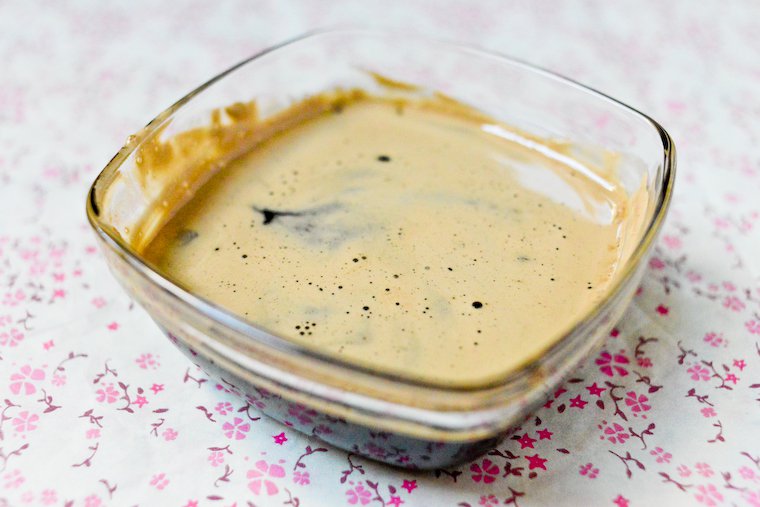
Muscovado syrup to serve with the black sesame panna cotta.
Join the conversation!
Have you ever cooked with black sesame paste, and what are your favorite uses for it? And do you like to make panna cotta, or did you tire of it when it was all anyone would serve?
* When Nanashi first opened, they hadn’t yet decided what to call it (surreal, but true). Naturally people asked and asked about a name, so they eventually just called it Nanashi, “no name” in Japanese. I don’t know whether or not it’s a reference to the anime character.
The restaurant now has three locations:
31 rue de Paradis, 75010 Paris, + 33 (0)1 40 22 05 55, M° Poissonnière
57 rue Charlot, 75003 Paris, +33 (0)1 44 61 45 49, M° Filles du Calvaire
Bonpoint, 6 rue de Tournon, 75006 Paris, +33 (0)1 43 26 14 06, M° Odéon
Transparency note: I received a review copy of Kaori Endo’s book. It also happens to be published by Hachette, the same publisher who will be releasing the French edition of The French Market Cookbook in early 2015. All opinions expressed are my own.
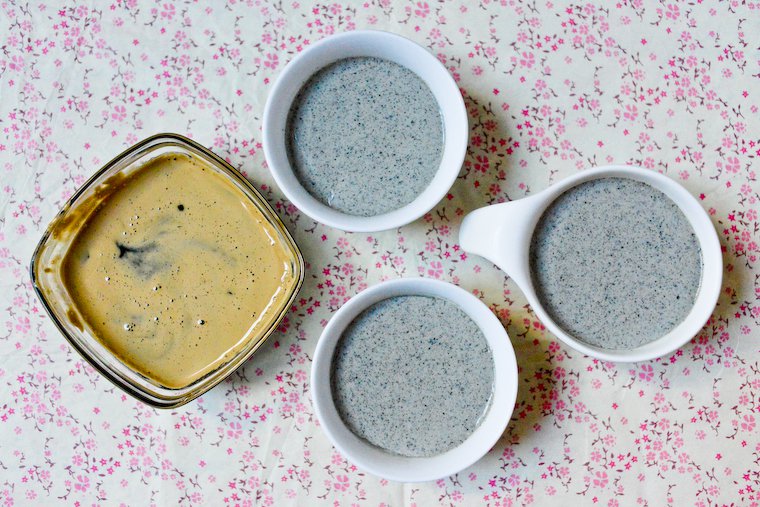

Have you tried this? Share your pics on Instagram!
Please tag your pictures with #cnzrecipes. I'll share my favorites!
Ingredients
- 4 sheets gelatin (9 grams total; see note)
- 300 ml (1 1/4 cups) milk, dairy or non-dairy (I used rice milk, the author recommends soy)
- 60 grams (5 tablespoons) unrefined cane sugar
- 50 grams (3 tablespoons) roasted black sesame paste (look for it at natural foods stores or Japanese markets, kuro neri goma)
- 300 ml (1 1/4 cups) whipping cream (I used 1/3 crème fraîche and 2/3 whipping cream)
- 100 grams (1/2 cup) muscovado sugar (available at natural foods stores)
Instructions
- Have ready six ramekins, small bowls, or glasses, about 120 ml (1/2 cup) in capacity each.
- Place the sheets of gelatin in a soup plate and fill with enough cold water to cover. Let rest for 5 to 10 minutes, flipping and poking them every once in a while for even soaking, until rehydrated and soft.
- In a medium saucepan, combine the milk, sugar, and sesame paste. Heat gently without ever reaching a simmer (to about 50°C or 120°F), stirring (not beating) regularly with a whisk, until the sugar is melted and the sesame paste is evenly dispersed. Turn off the heat.
- Press the sheets of gelatin in your hands to squeeze out the excess water. Add to the sesame milk and stir until dissolved.
- Empty an ice cube tray into a large mixing bowl and add a little water to create a shallow ice bath. Nest a medium mixing bowl into the large one so it is in full contact with the ice bath. Add a bit more water as needed.
- Pour the sesame milk into the medium mixing bowl, and stir in the cream.
- Let the mixture cool in the ice bath, stirring every 5 minutes with a spatula until the consistency becomes that of a thin custard: if you run your finger across the flat of the spatula, it should leave a clear trace.
- Pour into the prepared ramekins and let set in the fridge for at least 6 hours, or overnight.
- To prepare the syrup, put the muscovado sugar in a small saucepan and add 100 ml (6 tablespoons) water. Heat gently to dissolve, then let cool completely.
- Remove the panna cotta from the fridge 15 minutes before serving, and serve with the muscovado syrup if desired.
Notes
- Sheet gelatin is much easier to measure out and use than powdered or granulated, which means you get more consistent results. In France, there is only one kind available, but if you're in the US you will likely have a choice between different strengths; pick silver, or 160 bloom. If sheet gelatin is unavailable, substitute 1 tablespoon plus 1 teaspoon powdered gelatin, and follow David Lebovitz's instructions on how to rehydrate and use it.
- If you would like to unmold the panna cotta before serving, dip each rameking into a bowl of just boiled water for 5 seconds, then invert onto a serving plate.
- Adapted from Kaori Endo's book Les Bento de Nanashi.
